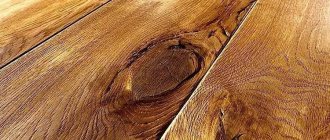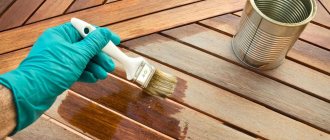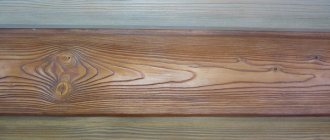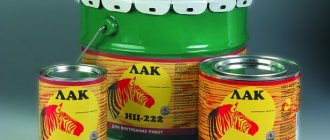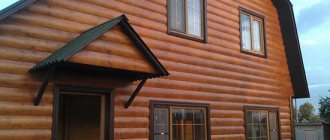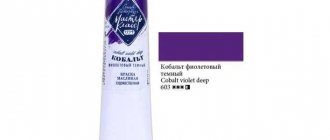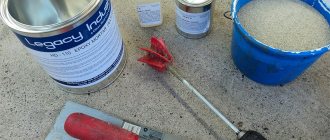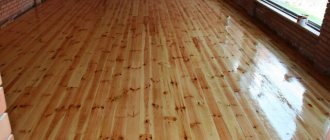Building materials, finished structures and household items made from natural untreated wood must be coated with special protective compounds, otherwise they will not last long.
A simple and reliable method of treating wood with oil has been used for many years. But modern industry produces so many varieties of oils and impregnations containing oils that it is easy to get confused. But there are also 100% edible vegetable oils, for example sunflower, flaxseed... Maybe they are better, more authentic?
Let's figure out what criteria to use to choose wood oil in each specific case.
Deciding what we need from the oil
Oils for processing and impregnation of wood can be classified according to the following criteria:
- Purpose - for external or internal work, for what types of wood, only for protection or also to add shade.
- Composition - natural or synthetic, how many additives it contains.
- Drying abilities.
The following are treated with an oil protective coating:
- Wooden products used for cooking: cutting boards, spatulas, spoons, bowls, etc.
- Wooden furniture and household items that must be safe: cribs, wooden toys.
- Wooden surfaces to protect against moisture, abrasion and pests.
Therefore, the composition of impregnations varies from completely vegetable to chemical - from an industrial laboratory.
The former are safe when ingested by the human body and in contact with skin, and when working with some synthetic oils it is necessary to wear a protective mask. The manufacturer indicates precautions when working with products on the label.
To process products used for cooking, 100% tabletop vegetable oils and industrial safe high-quality impregnations are used.
All natural vegetable oils dry (polymerize) slowly - about a week, or even longer. Therefore, during construction and repairs, ready-made industrial compositions are more often used. They dry in a few hours.
The content of natural oils and other ingredients in them varies depending on the tasks: protection from moisture, pests, adding shine, etc. Thus, G-Nature natural oil contains linseed, tung oil, rosin, and wax. They can be used to process countertops and cutting boards. And Osmo UV-schutz-Ol is used for garden furniture; it protects wood from sunlight.
Natural oils harden at different times. Sunflower takes longer to polymerize than others; it is sometimes called semi-drying. And there are oils that do not dry out at all, for example castor oil.
Popular oils for interior and exterior use:
- mineral;
- linen;
- woody;
- coconut;
- from several components.
Methods of applying impregnation
Before applying impregnation, the wooden surface should be prepared. To do this, remove the old coating (if any), dust and other contaminants. Then the wood is sanded with sandpaper in two passes: the first with sandpaper with P100 grit, the second with P150. After this, the surface is dust-free.
To successfully apply oil impregnation, the wood must be not only clean, but also dry. Its optimal humidity level is no more than 15%.
To apply oil impregnation, you can use a brush, roller or regular cotton cloth. In this case, you can either dip them into a container with liquid or pour it in small portions onto the surface, and then distribute it evenly.
Small items, such as souvenirs, are treated with oil by soaking. They are immersed in liquid and kept there until air bubbles stop escaping from the wood.
There are two main ways to perform such work:
- Cold. The first layer of oil is applied liberally to the prepared area. After 5-7 minutes, its excess is removed using cotton cloth. The absorption process lasts up to 48 hours. Then a second layer of oil is applied. After this, the wood dries within 30-45 minutes. Then excess oil is removed with a cotton cloth. After 12-18 hours, the surface can be polished to give it a pleasant satin shine. To do this, it is most convenient to use a polishing machine with a beige pad.
- Hot. In this case, the oil is heated in a water bath to approximately 80 °C and then applied to the prepared surface. All further actions are similar to the cold method. The only difference is that the second layer can be applied after 2-3 hours.
For some types of oils, applying the second layer can be done before the first layer dries, using the so-called wet method. An indication of this must be contained in the manufacturer's instructions.
Not all experts consider the hot method to be the best. In their opinion, it speeds up the drying time, but at the same time reduces the depth of oil penetration.
The surface treated with oil must be protected from moisture for 5-7 days. After this, it can be used as usual.
Oil consumption per unit area of a wooden surface depends on the quality of its preparation, as well as on the type and age of the tree.
You can see one of the options for applying oil to a wooden surface by watching the video:
Mineral oil
Mineral oil for wood processing has the following characteristics:
Which is better: heated floors or radiators?
Warm floorBatteries
- easy to apply;
- in itself it is colorless, but together with various additives it gives the surface a certain shade;
- tasteless and odorless;
- has high protective properties;
- dries quickly;
- combines with other coatings.
This synthetic oil is a product of petroleum processing, but it is already so familiar to humans and used in various spheres of life (cosmetology, food industry, medicine) that there have long been no complaints about its origin. Accordingly, it can be edible and non-edible.
The most famous is Vaseline and Vaseline oil based on it. True, it does not dry out and is used mainly as a lubricant, and not for processing wood.
In most cases, the manufacturer coats wooden kitchen utensils, countertops, and furniture with mineral oil for food use. Finding such oil on sale is not difficult: construction stores have a large selection of mineral oils for all types of finishing work.
Advantages and disadvantages of oil impregnations
Any paint coating forms a film on a wooden surface. It protects the tree from external influences, but at the same time makes air exchange impossible. Oils behave differently. They penetrate 5-7 mm deep into the wood, but do not clog the pores or affect the wood’s ability to “breathe”. In addition, such impregnations successfully mask small defects by filling them. They give the wood water-repellent and wear-resistant properties.
Compositions made from natural oils do not change the texture of the treated surface. On the contrary, they make the pattern more prominent, giving it a deep matte shine. The absence of a film allows the wood to naturally respond to changes in humidity, while the protective layer is not destroyed. Separately, it should be noted the high maintainability of oil coatings. If a defect appears, it is enough to partially remove them from a section of the wooden surface and then apply a similar composition to this place.
In general, oil impregnations have the following advantages:
- environmental friendliness;
- excellent water-repellent properties;
- resistance to changes in humidity and temperature;
- the ability to preserve and emphasize the natural texture of wood;
- breathability;
- easy application;
- maintainability.
At the same time, their shortcomings should be highlighted. Grease stains are clearly visible on oiled surfaces, so after treatment, wooden products need to be treated with care and regular maintenance. Considering that oil does not form a film, such stains may simply not be washed off with a damp cloth. They will have to be removed along with the protective layer.
Features of oil selection
Different oils can be used to impregnate wood. Common formulations of plant origin are often used: tar, hemp or flax. There are quite highly specialized liquids designed for certain types of wood. It’s quite easy to make a mistake here, so it’s better to choose impregnations with a wide spectrum of action, for example for hardwood. Some compositions additionally have a coloring effect. After they dry, the wooden surface acquires a more expressive shade.
This is approximately how you can display the “well-being” of a tree when using natural oil impregnations
Coconut oil
Exotic coconut oil is unusual for Russian people for wood processing, but it’s worth taking a closer look at. If only because it has a pleasant, tasty smell, gives the product a strong shine and, judging by reviews, practically does not go rancid, so coconut oil can be recommended primarily for kitchen utensils.
Do you want to get rid of the smell of linseed oil after impregnating wood with it? Treat the product with another layer of coconut oil.
Whether the oil is suitable for processing any wood is unknown. The practice of its use is still small, not least because it is very difficult to find coconut oil for wood on sale.
What brushes are best for applying oil?
If you have purchased natural wood oil or oil and wax, one of the most common ways to apply it is by using brushes. This is especially true if you need to apply the compositions to vertical wooden surfaces - walls and ceilings that have an uneven plane (shaped wooden panels and lining).
Combination bristle brushes are ideal for applying oil with hard wax. Because just such a brush, thanks to its natural base, will be able to evenly apply oil with hard wax, and the synthetic component will ensure wear resistance. Naturally, not every brush with synthetic hairs will be ideal; here you need to trust trusted manufacturers and the experience of professionals.
The most popular brush sizes are 40 mm, 60 mm, 80 mm and 100 mm.
- The advantage of brushes is that they can be used to apply oils in hard-to-reach and inconvenient places, for example, in the corners of a room.
- The disadvantages include applying oil with a brush to a large wooden floor. This process takes a lot of time, and working on your knees is not very convenient, even if you use special knee pads.
About quality and choice of brand
On sale, tung oil costs about 1,500 rubles. for 500 ml (enough to process 7 sq.m.). You should only choose products that indicate pure or 100% on the label, otherwise it is not pure tung oil, but a mixture with varnish. There is also polymerized tung oil. It is thicker and gives a thicker coating with shine.
For delicate items (such as musical instruments), the quality of the wood oil should be carefully assessed. Main selection criteria:
- Tung oil with a greenish tint and at a very low price - the quality of such a product cannot be high.
- There are three quality classes. The highest class is an oil of natural honey color.
- The environmental conditions under which the tree grew are of primary importance; the highest quality oil is produced from the seeds of specimens grown far from large cities (for example, in mountainous China).
When is the best time to use brushes?
One of the types of brushes are brushes. What distinguishes a brush from a brush is its width and the possibility of using an extension handle, which can be inserted into a special metal cup attached to one side of the brush.
Brushes can be of different widths: the most common brushes on the market are 200 mm, 300 mm and 500 mm.
Please note that when applying oil with a brush, it may splash in different directions. We recommend that you carefully consider this problem when applying oils in interior spaces, as drops of oil can fall on walls and furniture, leaving stains on their surface. A solution to this problem can be to stick special masking tape with a wide plastic film on the walls and furniture.
Brushes are indispensable when applying oil to terraces, especially if the decking board is corduroy. No other tool does this job better.
Pros and cons of wood oil
When looking for information about whether oil or wax is better for wood, you need to learn about the positive and negative sides of each composition. The substance for wood has the following advantages:
- ability to hide minor defects;
- improves the performance characteristics of wood;
- adding shine to the surface;
- increasing the service life of the product;
- relatively low cost;
- environmental Safety;
- ease of application;
- high availability;
- aesthetic component.
Like other materials, wood oil has some disadvantages:
- risk of grease stains;
- the need for additional surface care;
- the need to update the coverage after a year or two;
- drying time of the material.
AQUATEX® BALM
Natural wood oil
Ready-made color palette
| RECOMMENDED RETAIL PRICE * | |
| 605₽ | 0.75l |
| 1498₽ | 2l |
| *Price in different regions and stores may differ from the recommended one | |
Purpose:
- protection of wood: from biological damage (rotting, mold, fungus, blue stain)
- from UV radiation (darkening, fading)
- from atmospheric influences
Application area:
- Technical data
- Properties
- Recommendations for use
- Compatibility with other coatings
- Video
- Download certificates
- Expert advice
- exceptional environmental friendliness: contains only natural oils, retains the feeling of natural wood
- contains natural wax, gives wood water-repellent properties
- provides maximum protection against fading: contains UV filters of the UV-A and UV-B ranges, UV absorbers and transparent nano-pigments
- protects against biological damage: contains a difficult-to-wash-out antiseptic (a highly effective combination of fungicides)
- has excellent absorbency, penetrates deeply into the wood structure
- increases the wear resistance of wood: prevents the formation of scratches, abrasions and other damage to the surface
- forms a vapor-permeable (“breathable”) coating
- easy to apply: does not form smudges, does not require polishing, sanding, or sanding between layers
- does not crack, does not peel off, does not peel off
- easily restored (updated) only in individual areas that require it
Conditions of work
- t° of ambient air and surface from +5° to +40°С
- relative air humidity no more than 85%
- wood moisture content – no more than 20%
Surface preparation
- treat wood that has darkened over time with the bleaching composition WoodMaster™ Frost® or WoodMaster™ Frost® Prof
- Previously painted or damaged wood must first be cleaned (sanded, scraped, sanded) from old peeling coatings, dirt, putrefactive damage, foreign inclusions
- To enhance bioprotection and increase the service life of coatings used in open atmospheres and/or high humidity, it is recommended to pre-treat the surface with Aquatex™ Antiseptic Primer
- It is not recommended to apply the composition to surfaces previously treated with fire-bioprotective impregnating compositions WoodMaster™ and similar compositions from other manufacturers
- Brush, roller, sponge or spray
Why is processing needed?
During daily cooking, the cutting board is subjected to serious stress. It is regularly scratched with a knife or a kitchen hammer; moisture, juices from vegetables and fruits penetrate into the pores of the material, and dish soap may not be completely washed out of them. The average period of use of wooden utensils is about a year, after which they lose functionality and attractiveness.
Special treatment of the cutting board with oil compounds allows you to fill the pores of the wood and prevent wetting, swelling, and deformation of the product. Impregnation also has the following purposes:
- prevention of absorption of unpleasant odors by wood;
- prevention of cracks, chips, and other defects;
- preventing the colonization of the material by harmful microorganisms;
- preventing rotting and microbial toxins from entering food.
With periodic use of impregnation, the service life of the cutting board increases, which will seriously save money, because such products are not cheap. Primary processing should be done immediately after purchasing the utensils, while they have not yet been used in cooking.
It is important not to wash the product before soaking, because oils can “lock” remaining moisture inside the wood fibers. To really extend the life of your board, you need to treat it regularly.
Solvents in oils for exterior and interior woodwork
Regardless of the conditions of use, oils for wooden surfaces are divided into two types: solvent-soluble and water-soluble.
Organosoluble products contain white spirit or other organic solvents. Oil emulsions contain water. Modern solvent-soluble oils do not have a strong odor and meet standards for the content of volatile substances, so they can be used indoors.
The principle of working with products is the same. Water-soluble and solvent-soluble oils do not require dilution and are applied after mixing.
Comparative aesthetic characteristics
Comparing the aesthetic effects of varnish and oil on wood, it should be noted:
- Varnish creates more shine compared to oil.
- The surface coated with varnish is smoother and more gliding.
- The varnish coating is not tactile, while the oil is more noticeable.
- Oil preserves and more strongly conveys the natural texture of wood compared to varnish.
Some of the difference in aesthetic perception is due to the fact that the varnish creates a denser layer on the surface, while the oil is absorbed into the wood structure. This is the reason that with the same number of coats applied, oil and varnish create different visual effects.
If you prefer the wood of the product to remain as natural as possible and convey the texture of the wood, choose oil.
